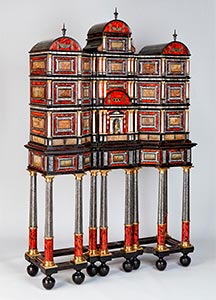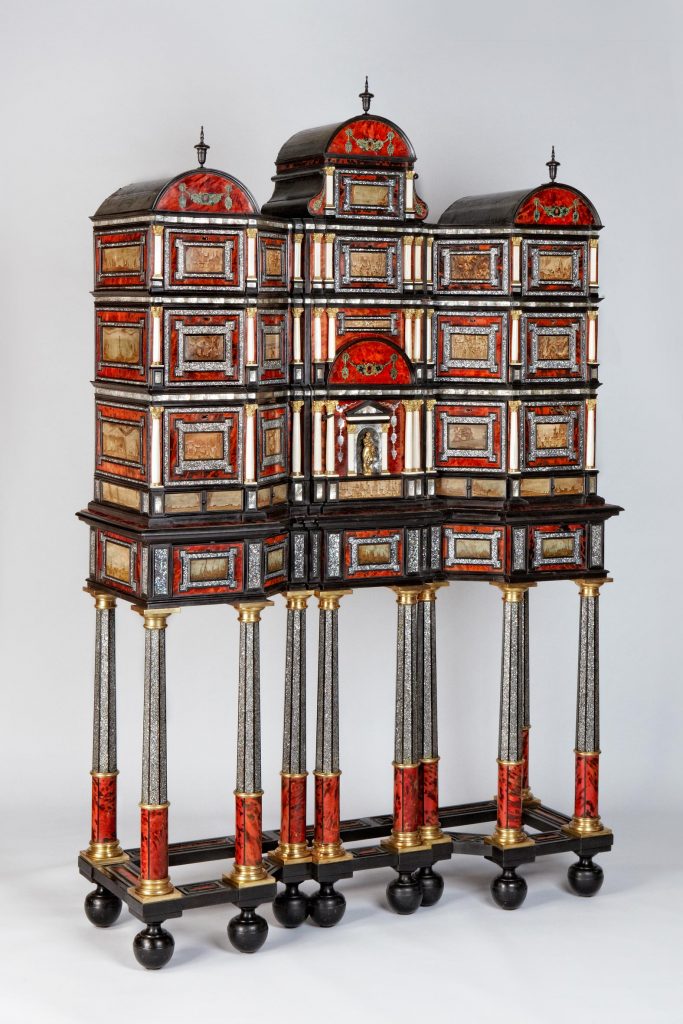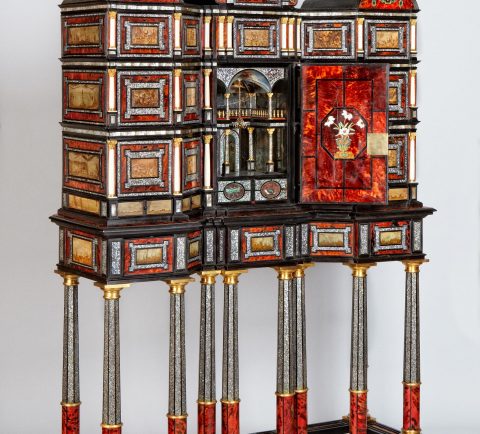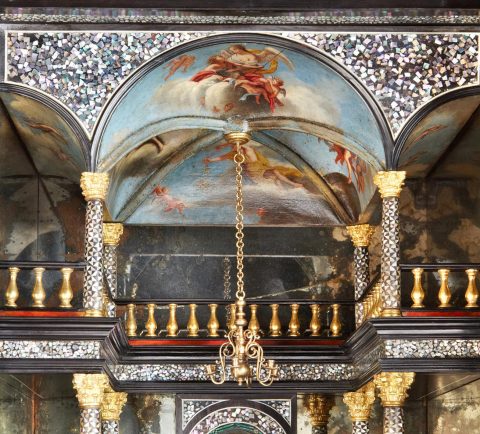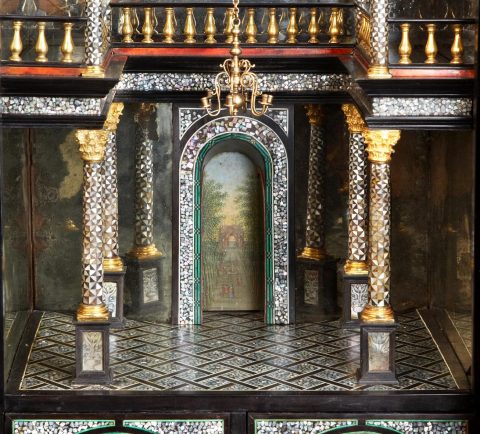A Cabinet-on-Stand
Cabinet-on-Stand
attr. to Pierre Gole (1620 – 1685)
Paris, ca. 1660
Tortoiseshell, pearl-shell mosaic, “pietra-paesina” panels, ivory, ebony,
green-stained horn and ormolu.
height | 209 cm (6 feet 10 inch)
width — 138.5 cm (4 feet 6½ inch)
depth \ 46 cm (1 feet 6½ inch)
This imposing, brightly decorated cabinet was made in 1660, at a time when parisian ébénisterie was just out of its infancy, but, as this piece demonstrates, had swiftly attained a high level.
further illustrations
Cabinet-on-Stand by Pierre Gole
The cabinet-maker Pierre Gole (1620 – 85) was born and raised in the Dutch Republic, but moved to Paris at an early age. By 1650 he was one of the most successful foreign craftsmen working in the French capital, and in 1651 he was appointed menusier en ébène ordinaire du Roi to the young Louis XIV. There is no record of this work for the king in the 1650s, but during that decade Gole executed many important commissions for Cardinal Mazarin, the all-powerful Italian-born minister, who assembled a magnificent art collection. Following the cardinal´s death in 1661, Louis XIV began his personal rule and simultaneously instigated the great campaign to enlarge and furnish the palace of Versailles. At the outset of this enterprise, Gole was his principal cabinet-maker, although by no means his only one.
This cabinet is distinguished by its architectural design and the splendor of its various components. The composition is based on vertical lines that run upwards from the feet through the legs and the panels above them to the upright sections with columns of the surrounds of the cabinet´s drawers. The upper part ends in a triple domed top inlaid with green-stained horn festoons, crowned by pointed ebony vases. Veneered with tortoiseshell, patterns of mother-of-pearl against an ebonised ground, green-stained bone combined with “pietre-paesina” panels flanked by ivory columns heightened with bases and Corinthian capitals of gilt bronze, the cabinet gains a gay, polychromatic effect.
Since the 1620’s the use of “pietre-paesina” or “landscape stone” was employed for decorative effects when panels of it were mounted on cabinets; the Albanese limestone after being polished reveals a natural pattern of mountainous rocky outlines.
The central door bears in a niche the statue of Hebe, the greek goddess of youth, flanked by two columns and a tympanum above. A “pietre-paesina”-panel across the arch bears the date “1660”, inlaid in mother-of-pearl.
The early cabinets spring their colourful surprise only when opened their door – this gives an access to the central compartment, an imaginary palatial architecture with mirrors at the walls to reflect and duplicate the interior work.
At ground level an ivory-lined parquetry-floor executed with thousands of small ebony and mother-of-pearl patterns passes over in the middle to a mirrored archway, giving a view to a renaissance-garden through an alley with a fountain and flaneurs. By using the rules of perspective it creates an illusion of greater distance, like a visitor could pass through. The first floor with a collonade bounded by a gilded balustrade. A tiny, flemish ormoulu chandelier hanging on a long chain from the vaulted ceiling which is painted with allegorical scenes in the manner of painter Henri Gascard. Underneath the floor two drawers inlaid with oval details depicting a hopper and a snail, surrounded by mother-of-pearl inlays, two secret drawers behind.
By comparing the cabinet with further examples executed by Pierre Gole, there are additional similarities: a table in the Musée Smidt van Gelder, Antwerpen, shows on the stretcher a lizard and a salamander, all surrounded by the same mother-of-pearl patterns on an ebony ground (att.1); a cabinet in the Dallas Museum of Art shows in the front the same niche with a gilded statue under a tympanon – inlaid with the same mother-of-pearl patterns on ebony ground, which repeat themselves also in the bordures of the drawers, the panels and the columns (att.2).
Gole was doubtless familiar with these exceptional technic, most likely inspired by the mother-of-pearl inlays of Japanese lacquer cabinets of the Momoyama period (1573 – 1615), which have been highly coveted luxury goods at the beginning of the 17th century at the European courts (Att.3). Also the use of pietra-dura or pietre-paesina plaques in combination with the „mother-of-pearl mosaic“ was employed by Pierre Gole, as according to tradition he delivered two cabinets of this type to Cardinal Mazarin in 1658/59, but many pieces that Gole made for him and the king were probably dismantled when they were sold off from the Royal Collection 1741 and 1751.
The great hall of Nostell Priory, Yorkshire, which is famous for its exceptional interiors keeps in its collection a cabinet excecuted by Pierre Gole pearlshell mosaic with inset pietre-paesina panels at the drawers and the central door also flanked by ivory columns with gilded bases and Corinthian capitals (att.4).
Gole´s workshop was situated on the Rue de l´Arbre Sec, but it seems probable that he also had the use of premises at the Gobelins for his Royal commands. The famous tapestry of the visit of Louis XIV to the Gobelins factory in 1667 shows two ébénists, one of whom is obviously Domenico Cucci, and the other can only be Pierre Gole, holding up a tortoiseshell marquetry table of a type of which he supplied many for the Royal Palaces.
Among the more illustrious of his clients that are listed, the Princess de Carignan stands out, along with the Princesse de Mecklembourg, the Princess de Bade, Louise de Savoie and Marie de Bourbon. This demonstrates his splendor not only in the French capital but also at European courts. The listed comparison with above-mentioned authentic works by Pierre Gole make the attribution of this cabinet to him with a great degree of confidence.
Provenance
Private collection, Italy
Literature
- Th. H. Lunsingh Scheurleer: “Pierre Gole, ébéniste des Louis XIV”, 2005, p. 112 ff, fig. 73, 77, 79
- R. Baarsen: “Paris, 1650-1900”, 2013, p. 42, fig. 4ff





